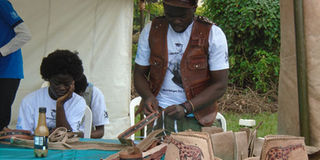Refugee finds solace in making leather products

Kasereka Kahamba makes final touches on a belt during celebrations for World Refugee Day in Kampala at the weekend. Below are some of his leather products. Photo by Gillian Nantume
What you need to know:
Forced into a refugee settlement camp at an early age, Kasereka Kahamba is determined to change his destiny by making leather products for sale.
At the Kampala celebrations of the World Refugee Day held at Old Kampala Secondary School at the weekend, many refugee groups displayed crafts, shoes and other goods that they had made, for sale.
However, Kasereka Kahamba, 27, stood out for the number of male customers inspecting his products. Displayed on a table were Stetson hats, wallets, and belts, made from pure leather.
“All my products are handmade and I tailor them to meet the need of specific groups – the rich and the poor,” he says, adding: “For instance, I have discovered that rich men love to wear Stetsons, so I sell them at Shs60,000 each, and the leather gilets at Shs100,000 each.”
To help him cut the expenses, an NGO donated to him tanning chemicals in 2014, although they are getting depleted.
Escaping war in DR Congo
Kahamba’s home is in Rwamwanja Refugee Settlement in Kamwenge District.
“I came to Uganda in 2013 without my family. When I got a house in the settlement, I adopted an orphaned teenage refugee boy. While I am in Kampala, he takes care of the home.”
Kahamba lived with this parents and brother in Rwanguba, Goma, DR Congo. After completing university at Institut Supérieur de Commerce (ISC), Goma in 2013, he worked in a factory in Ruchuru, making covers for walkie-talkies.
“We branded the covers with the name of our village. When the rebels found some government soldiers’ with those walkie-talkies, they thought we were collaborating with them. They attacked our home each one of us ran in a different direction.”
Kahamba was captured and taken to Bunagana to do chores in the rebel camp. One day, as he was collecting firewood, he came across Ugandan policemen.
“I run to them and narrated my ordeal. They took me to Nyakabande Transit Centre in Kisoro District. Later, I was transferred to the settlement. Life was hard there because I did not know the language. To make ends meet, I began mixing cement and digging in people’s gardens.”
Kahamba does not know the whereabouts of his parents and brother, and as such, he was the only member of his tribe – the Nande in the settlement.
“The other refugees belonged to bigger tribes, such as the Banyabwisi, who were among the rebels back home. So, in case small jobs came up, no one seconded or supported me to get them. When official communication came through to the settlement, I took long to receive it because there was no one to interpret for me.”
Getting a scholarship
In 2014, a friend from Kahamba’s village called him for directions to Rwamwanja. He was still in DR Congo, planning his escape.
“I begged him to first return to our house and retrieve my academic transcripts. He agreed and came with them to Rwamwanja. Currently, he is in Geneva, Switzerland, studying.”
The refugees were encouraged to apply to Bugema University and Kahamba passed the interview and is now studying Disaster Management.
As he searches for his family members, instead of wallowing in self-pity, Kahamba created a job for himself from which he is earning a modest income.
Refugee status
The belts are sold between Shs10,000 to Shs50,000, while the wallets are sold between Shs15,000 to Shs20,000. Kahamba gets cow and goat skin from abattoirs, and then tans it. Goat skin costs Shs5,000 while cowhide costs between Shs40,000 to Shs50,000.“I tan the leather using local chemicals from trees that grow in cold weather in Kisoro, Kabale, and Kanungu districts. It is expensive to buy a tree, cut it down and transport it to my home.” Kahamba also says he has discovered that rich men love to wear Stetsons, so he sells them at Shs60,000 each, and the leather gilets at Shs100,000 each. “I am trying to develop my talent and teach other youth from the refugee settlement to do the same.”
[email protected]




